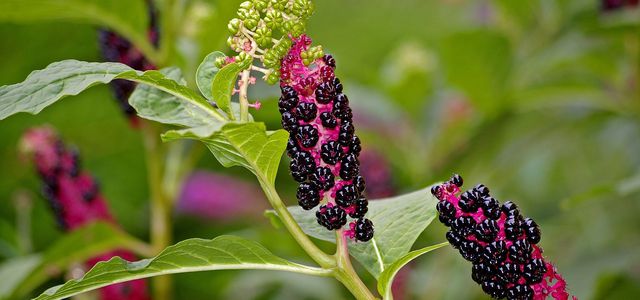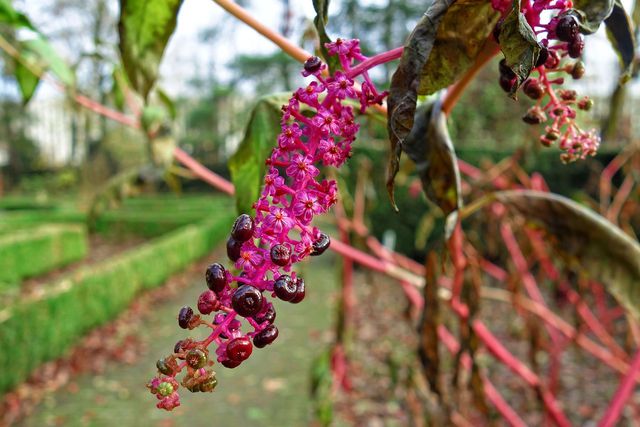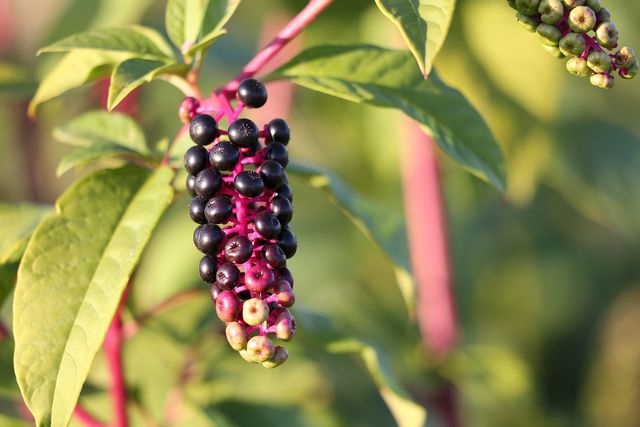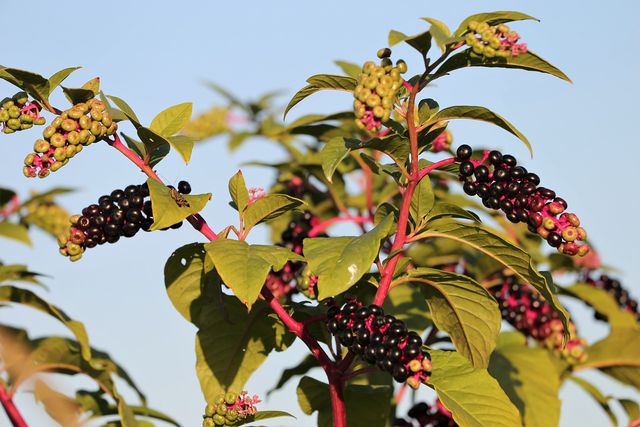
Kermesberry is a popular plant because of its black-red fruits. However, it spreads very quickly, especially in mild areas. Here you can learn how to combat the wild growth of pokeweed and how to plant and use the plant in a controlled manner.
Contents
The pokeweed: an invasive plant species?
Even though pokeweed is very pretty to look at with its colorful fruits, it is not very popular with many gardeners. This is because the perennial grows very quickly to a height of up to two meters, depriving other plants in your garden of light. In addition, pokeweed is a popular food source for birds, which in turn spread the plant’s seeds. Because pokeweed is originally from Asia and America and is spreading more and more into native forests, it is an invasive species.
In Europe, there are two main types of pokeweed:
Asian pokeweed (Phytolacca acinosa): The Asian or Indian pokeweed is best recognized by its vertically upright inflorescences. It is particularly common in Europe.
American pokeweed (Phytolacca americana): In contrast to the Asian pokeweed, the flower heads of the American pokeweed hang downwards. It is much more sensitive to frost and is therefore only found in warmer areas, for example in southern Europe.
Caution. Both the American and Asian pokeweed contain saponins that are toxic to humans. Especially the American species contains a lot of the toxin. Therefore, with both species, you should not consume the fruits or other parts of the plant.
How to control the pokeweed naturally

If a pokeweed has settled in your garden, you should make sure that it cannot form fruits. This will prevent it from spreading its seeds in your garden.
These three tips will help you against pokeweed:
Prevent early: once pokeweed seeds, it is very time-consuming to remove all new seedlings. Therefore, you should make sure that no fruits can form in the first place. Cut off the flowers as soon as they wilt.
Remove young plants in early summer: In early summer, roots of new pokeweed are still relatively tender and easier to dig up. It’s best to weed the young plants when the soil is still moist from rainwater.
Dig up taproots: With older specimens of pokeweed, it is no longer sufficient to cut off only the upper parts of the plant. Here you have to dig up the plant including the taproot.
Important: Always use gardening gloves when working with pokeweed. The saponins contained in the plant can cause skin irritation.
Report pokeweed to the Nature Conservancy.
Because pokeweed is considered an invasive species, it can quickly become a threat to native plant species in the wild. If you discover wild pokeweed outside your garden, for example in the woods, you can report it to the Nature Conservancy’s Naturgucker. In this way, you help to make more known about where and how quickly the pokeweed is spreading nationwide.
Plant pokeweed purposefully

Kermes berries are spreading, but also beautiful to look at. In the following section, you’ll learn how to plant them specifically.
The right variety: At the garden supply store, you’ll need to decide which variety of pokeweed you want to plant. The Asian pokeweed is the most suitable, as it is relatively resistant to frost and less toxic than the American pokeweed.
Plant pokeweed:
Optionally, mix some compost into the soil first before planting the pokeweed. This is especially useful if the soil is sandy or clayey.
Now dig the planting hole. It should be at least twice the size of the root ball. Always leave a space of 80 to 100 centimeters between the planting holes when planting several plants.
Place the pokeweed in the hole and lightly press the soil all around.
Water the plant.
The right location: The pokeweed quickly takes the light from other plants with its tall growth. Therefore, do not plant it near plants that need a lot of sun and grow rather low. Otherwise, pokeweed feels comfortable in both sunny and partial shade locations.
The right soil: The pokeweed makes hardly any demands on the soil. Loose, nutrient-rich soil that is rich in humus is ideal.
The right care: The pokeweed hardly needs any additional care. Just make sure that you water the plant regularly and always keep the soil slightly moist. Good watering water is stagnant rainwater from a rain barrel or water from a pond. If you want to prevent pokeweed from spreading uncontrollably, you should always cut off wilted flowers immediately.
Pokeweed as a natural protection against slugs and snails

If you regularly have to deal with slugs in your garden, pokeweed can be a useful tool. Especially the poison of the American pokeweed is effective against slugs.
For the slug protection from pokeweed you need:
- about 1 L of rainwater
- about 4 tablespoons of crushed pokeweed seeds.
This is how you make the snail protection:
Put on gloves and remove the seeds from the fruit.
Grind the seeds carefully with a mortar.
Mix the ground seeds with about a liter of water and water the infested beds regularly with the solution.
The decoction from pokeweed is an effective, but not very gentle way to get rid of slugs: the saponins it contains attack the slugs’ mucous membranes and break down their eggs. How to get rid of snails without harming them, explains this article: Fighting slugs in the garden: tips and natural remedies.
The pokeweed as a medicinal plant in homeopathy
The pokeweed is not edible, however, preparations with extracts of the American pokeweed are used according to netdoktor.de especially in homeopathy. According to the health portal, homeopathic products with pokeweed should help with the following diseases. Note, however, that it is controversial in science whether homeopathic remedies actually work:
- Sore throat
- toothache
- Menstrual cramps
- vomiting and diarrhea
- inflammation of the mammary glands
- Problems with breastfeeding

